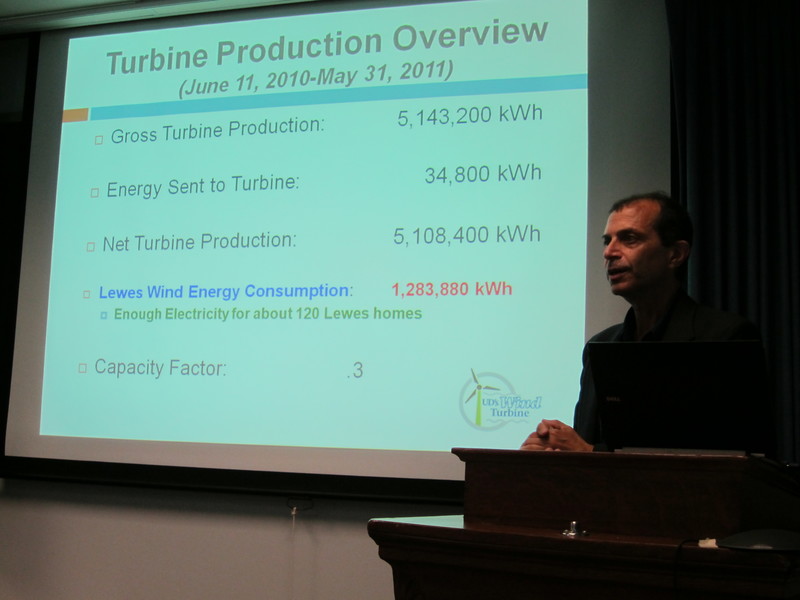UD’s wind turbine powering campus plus more than 100 Lewes homes
University of Delaware’s electricity-generating wind turbine at the College of Earth, Ocean and Environment powered the entire Lewes campus for the past year and produced enough excess capacity for an additional 120 Lewes homes.
In addition, the turbine is generating important data about corrosion in a coastal environment and possible impacts of turbines on bats and birds along the Atlantic coast,
That information and more was presented to interested people in the Lewes area during a public presentation by the university at the college on Thursday, June 22. Speaking were College Dean Nancy Targett and two university professors – Willett Kempton and Jeremy Firestone – who have been involved with the turbine project from its inception. Kempton is an authority on wind generation and Firestone is involved in public policy aspects of wind generation. About 100 people attended the evening presentation in the meeting room of Cannon Laboratory.
Firestone said during the windy months from September through May, the turbine is producing more electricity than the campus uses.
As for impact on birds, Targett said preliminary data shows “very little to no bird impact to date. But before we say anything more on that we want to wait until a full year has passed so there can be a full report.” Bird monitoring in an area 170 meters square around the turbine, and including acoustic and thermal imaging, started in March of 2011.
Firestone said a sound study conducted following installation of the turbine determined that the turbine is increasing ambient sound in areas around the turbine by just a few decibels. “New devices in an area are not permitted to more than double the ambient decibel level,” said Firestone. “The most recent study showed that the turbine increased the daytime ambient sound by 1.1 decibels and the nighttime level by 2.9 decibels. That’s far below that doubling standard.” An increase of 10 decibels is considered a doubling of sound.
Kempton said the purpose of the wind turbine is to help gather data that can inform the discussion about possible offshore turbine farms. “We can learn a lot more here about what to expect in an offshore wind turbine environment than we can at turbine installations in West Virginia. This is the one windy region onshore in Delaware. We wish that energy company NRG had been able to install its meteorological tower offshore this year but it looks like problems with federal loan guarantees have put that off by at least a year.”
Despite the apparent success of the Lewes turbine to date, Targett said the University has no plans to erect any more. “I say that because I just received calls today saying that people were hearing we’re planning to put up two more towers or that we’re going to take this one down and replace it with two smaller towers. Neither of those two scenarios is true.”
That, however, doesn’t mean there aren’t other parties watching the Lewes experiment closely for possible commercial purposes. Kempton said two parties in the region have expressed an interest in the turbine and are awaiting the results of the avian impact study before moving ahead with further analysis. ‘We’ve been approached by others wondering about the applicability of this turbine for other locations along the ocean coast or along the upper Delaware Bay,” said Kempton. Targett said a town in North Carolina has also made inquiries about the turbine.
People attending the presentation had lots of questions about the turbine but no one made any negative comments about the structure or its operation.
Conversely, the audience applauded when Sussex County League of Women Voters President Cathy Ward praised University of Delaware for being out in front in wind-turbine research. “As a policy, we support green energy,” said Ward. “We think the turbine is beautiful. We love it.”


















































